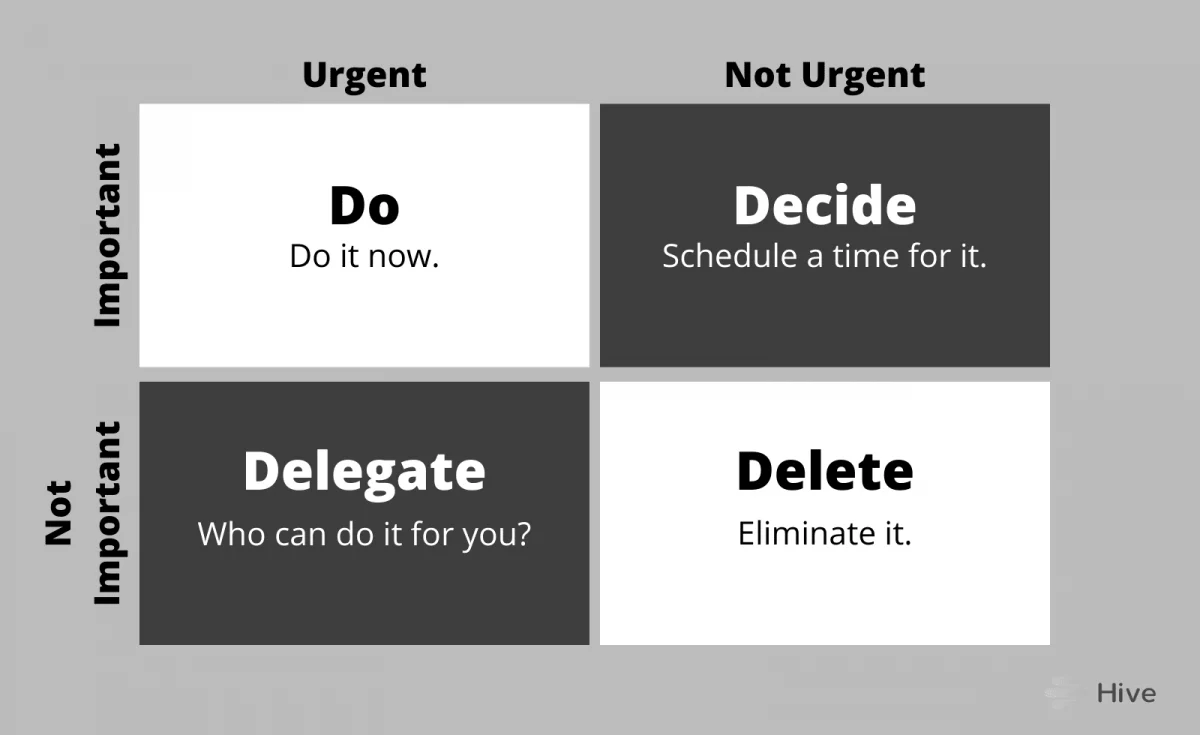Introduction
The Eisenhower Matrix, also known as the Urgent-Important Matrix, is a powerful mental model that helps individuals prioritize tasks and make effective decisions. This matrix, developed by former U.S. President Dwight D. Eisenhower, categorizes tasks into four quadrants based on their urgency and importance. Understanding and utilizing the Eisenhower Matrix can significantly enhance decision-making processes by enabling individuals to allocate their time and energy more efficiently. In this blog post, we will delve into the concept of the Eisenhower Matrix, its relevance in decision making, its anchoring in human psychology, and its prevalence in our day-to-day lives.
Defining the Eisenhower Matrix
The Eisenhower Matrix is a visual tool that divides tasks into four categories:
- Important and Urgent: Tasks that require immediate attention and are crucial to achieving long-term goals.
- Important but Not Urgent: Tasks that contribute to long-term objectives but do not require immediate attention.
- Urgent but Not Important: Tasks that demand immediate action but do not align with long-term goals.
- Not Urgent and Not Important: Tasks that offer little value and should be eliminated or minimized.
Relevance in Decision-Making Processes
The Eisenhower Matrix is highly relevant in decision making as it provides a systematic approach to prioritization. By categorizing tasks based on urgency and importance, individuals can allocate their time, energy, and resources more effectively. This model prevents individuals from getting overwhelmed by the urgency of tasks and allows them to focus on what truly matters in both personal and professional contexts.
Anchoring in Human Psychology
The Eisenhower Matrix is anchored in various aspects of human psychology that influence our decision-making processes:
- Procrastination Tendency: Humans have a natural inclination to prioritize tasks that provide immediate gratification or are more enjoyable, often neglecting important but non-urgent tasks. The Eisenhower Matrix helps combat this tendency by highlighting the significance of long-term goals.
- Bias toward Urgency: Our brains are wired to respond to urgent tasks due to the fight-or-flight response. As a result, we tend to gravitate toward tasks that demand immediate attention, even if they are not necessarily important. The Eisenhower Matrix challenges this bias by emphasizing the importance of focusing on tasks aligned with long-term goals.
- Overwhelm and Decision Fatigue: When faced with a multitude of tasks, decision fatigue can set in, leading to suboptimal decisions. The Eisenhower Matrix provides a structured framework that simplifies decision making by guiding individuals to prioritize tasks based on their importance and urgency.
Examples of the Eisenhower Matrix
- Personal Life Decisions: Imagine an individual juggling various responsibilities, including work, family commitments, and personal goals. By utilizing the Eisenhower Matrix, they can identify which tasks are truly important and align with their long-term aspirations. For example, exercising regularly to maintain good health may fall into the Important but Not Urgent quadrant, highlighting the need to prioritize it over less crucial tasks.
- Business Scenarios: In a business setting, an entrepreneur faces numerous demands, including client meetings, administrative tasks, and strategic planning. By applying the Eisenhower Matrix, they can identify tasks that contribute to business growth and prioritize them over less important and urgent tasks. This approach helps avoid reactive decision making and allows for a focus on important, long-term goals.
- Public Policy-Making: Public policymakers often encounter urgent issues that demand immediate attention. The Eisenhower Matrix helps them evaluate the importance of various policy decisions and determine which ones align with long-term societal goals. By allocating resources and attention based on importance, policymakers can make more informed and effective decisions.
Mental Biases and Psychological Underpinnings
Several mental biases influence how individuals utilize the Eisenhower Matrix:
- Anchoring Bias: Individuals may anchor their decisions on the urgency of tasks rather than their importance, leading to suboptimal prioritization.
- Loss Aversion: People tend to prioritize urgent tasks to avoid perceived losses, even if those tasks are not aligned with their long-term goals.
- Social Pressure: The fear of missing out or the pressure to respond quickly to external demands can distort prioritization, leading to an overemphasis on urgent but less important tasks.
Identifying and Avoiding Eisenhower Matrix Pitfalls
To avoid falling into the Eisenhower Matrix trap, consider the following strategies:
- Goal Alignment: Clearly define your long-term goals and regularly assess tasks against those objectives. This helps maintain focus and prevents the allure of urgency from derailing your priorities.
- Time Blocking: Allocate dedicated time blocks for important but non-urgent tasks to ensure they receive sufficient attention. This proactive approach prevents important tasks from becoming urgent.
- Delegation and Elimination: Delegate tasks that are not aligned with your core competencies or long-term goals. Additionally, eliminate tasks that offer little value or are not necessary for your overall objectives.
- Decision Journaling: Maintain a journal to document your decision-making process and track the outcomes of your prioritization. Reflecting on past decisions can help identify patterns and improve future prioritization.
Conclusion
The Eisenhower Matrix serves as a powerful tool for effective decision making and task prioritization. By understanding its relevance in decision making, its psychological underpinnings, and the prevalence of biases that can undermine its effectiveness, individuals can leverage this mental model to optimize their personal and professional lives. By identifying when they might be succumbing to the Eisenhower Matrix and adopting strategies for objective decision making, individuals can make more informed choices, achieve their long-term goals, and lead a more balanced and fulfilling life.
